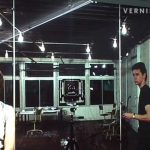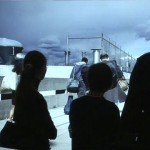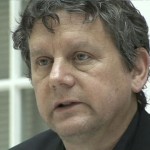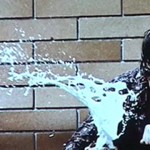Jeff Wall at the Fondation Beyeler in Riehen (Basel, Switzerland) is a comprehensive solo show that features more than 50 works of the Canadian artist. Spanning five decades, the retrospective presents a recent works, usually in counterpoint to older pictures. Many of the artist’s most famous works are included, such as “Milk”, 1984; “After ‘Invisible Man’ by Ralph Ellison, the Prologue”, 1999–2000; or “A Sudden Gust of Wind (after Hokusai)”, 1993. The exhibition places particular emphasis on works produced in the last two decades, among them photographs on public view for the first time. The exhibition has been conceived in close collaboration with the artist. Jeff Wall at Fondation Beyeler runs until April 21, 2024.
Jeff Wall. Retrospective at Fondation Beyeler, Riehen (Basel, Switzerland). Media Preview, January 26, 2024.
— Right-click (Mac: ctrl-click) this link to download Quicktime video file.
Press text (excerpt):
At the beginning of the new year, the Fondation Beyeler is devoting a comprehensive solo show to Canadian artist Jeff Wall (b. 1946). It is the first exhibition of such scope in Switzerland in close to two decades. Wall has contributed significantly to establishing photography as an autonomous art form and is regarded today as one of its foremost practitioners. Featuring more than 50 works spanning five decades, the exhibition presents a comprehensive overview of the artist’s ground-breaking oeuvre, from his iconic large-scale transparencies displayed in lightboxes to his large-format black-and-white photographs and inkjet colour prints. The exhibition places particular emphasis on works produced in the last two decades, among them photographs on public view for the first time. The exhibition has been conceived in close collaboration with the artist.
In his work, Jeff Wall probes the boundary between fact and invention, chance and construction. From the mid-1970s, he has explored ways to expand the artistic possibilities of photography. Wall calls his work ‘cinematography’, seeing in the cinema a model of creative freedom and invention that had been subdued in the dominant definition of photography as ‘documentary’. Many of his photographs are constructed images that involve extensive planning and preparation, collaboration with performers, and ‘post production’ work. Jeff Wall thus creates images that diverge from the notion of photography as primarily a faithful documentation of reality.
Wall was born in 1946 in Vancouver, Canada, where he lives and works. He began engaging with photography in the 1960s—the heyday of Conceptual art. From the mid-1970s, he began producing large transparencies mounted in lightboxes. With this format, till then associated more with advertising than with photography as an art, he pioneered a novel form of artistic display. Since the mid-1990s, Wall has expanded his repertoire—first with large-format black-and-white photographs and more recently with colour prints. His work has been the object of numerous solo shows worldwide, among others at Tate Modern, London (2005), the Museum of Modern Art, New York (2007), the Stedelijk Museum, Amsterdam (2014) and the Glenstone Museum, Potomac (2021).
As Jeff Wall’s imagery evolves between documentary recording, cinematic composition, and free poetic invention, viewers are confronted with a broad array of subjects and themes, faced with beauty and ugliness, ambiguity and disquiet. Wall feels that the art of photography ought to be as free in its range of subject and treatment as all the other art forms—to be as poetic as poetry, as literary as the novel, as painterly as painting, as theatrical as theatre, all with the aim to be essentially photographic.
The exhibition at the Fondation Beyeler opens in the museum foyer with the juxtaposition of two iconic works from 1999. Morning Cleaning, Mies van der Rohe Foundation, Barcelona shows the early-morning preparation carried out in the famous pavilion before the first visitors arrive. The custodian is seen in the process of cleaning the large windows facing a reflecting pool, showing us a moment in the life of this famous building that is usually hidden from view. A Donkey in Blackpool depicts a modest yet visually rich stable occupied by the familiar animal seen in a moment of repose. The pairing of the two pictures brings together very different social and cultural worlds while directing attention to their commonality—human and animal both have deep relationships to the interiors which shelter them. The exhibition has been planned to create a sequence of such comparisons and juxtapositions, creating echoes and resonances between subjects, techniques and genres. For the catalogue, the artist has written a ‘room guide’ that discusses the different dimensions of both the making of the pictures and their grouping in the exhibition.
For example, the first room of the exhibition displays a series of transparencies mounted in lightboxes centring on landscapes. Produced between 1987 and 2005, these cityscapes open onto a wide view of urban and suburban areas of Vancouver. Jeff Wall views cityscapes as an important aspect of his work, allowing him to explore the essence of the city, its relation to surrounding non-urban or suburban areas, and its nature as the setting of the endless web of events that make up social life.
The following rooms bring together scenes made in many different interiors and exteriors, public and private, scenes of groupings of men and of women, of the poor and the affluent, the young and the old—, of pictures made with elaborate artifice and labour, and others with almost no apparent effort, of both colour and black-and-white, transparent and opaque, large and small, of the real and the unreal, and of many moods, states of mind, and relationships.
Many of the artist’s most famous works are included, among them After ‘Invisible Man’ by Ralph Ellison, the Prologue (1999-2000), a construction of a scene from Ellison’s 1952 novel that shows the young black hero of the tale at work writing the book’s story in his secret basement hideaway lit up with exactly 1369 lightbulbs. A Sudden Gust of Wind (after Hokusai) (1993), one of Wall’s largest works, is a contemporary adaptation of a print in Katsushika Hokusai’s woodblock series Thirty-six Views of Mount Fuji (1830–1832). Both these pictures have their origins in works by other artists; Wall has given himself the freedom to find his subjects anywhere his imagination leads him. A Sudden Gust of Wind was among the artist’s first uses of digital technology, which makes it possible for a number of individual negatives to be combined into a single final image.
Most of Wall’s recent works are featured, usually in counterpoint to older pictures. Fallen rider (2022), an image of a woman just having been thrown from her horse, hangs across from War g ame (2007), in which three young boys, apparently captured during a game of combat, lie flat under guard in a makeshift prison. In Parent child (2019), a little girl also lies down, this time on a sidewalk in the gentle shadow of a tree, contemplated by a man, likely her father. Like film stills, Wall’s photographs seem to capture an instant as it unfolds – the before and after remain out of view. On the adjacent wall hangs Maquette for a monument to the contemplation of the possibility of mending a hole in a sock made in 2023, in which another contemplative figure, an older woman, holding a sewing needle, gazes at a hole in the worn heel of a purple sock. The mender appears unreal, an apparition reminding us of the uncertainty of mankind’s will and ability to repair what has been overused, worn out and damaged.
The exhibition has been curated by Martin Schwander, Curator at Large, Fondation Beyeler, in collaboration with Charlotte Sarrazin, Associate Curator.







